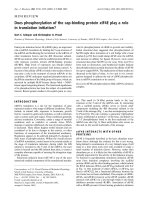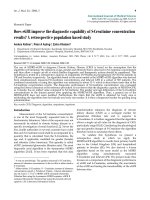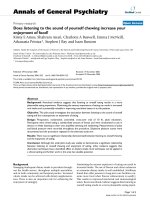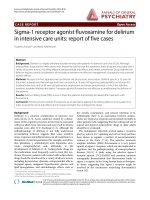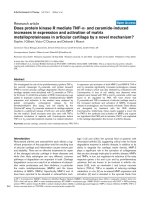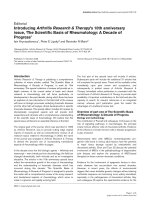Báo cáo y học: "Does intensive insulin therapy really reduce mortality in critically ill surgical patients? A reanalysis of meta-analytic data." pdf
Bạn đang xem bản rút gọn của tài liệu. Xem và tải ngay bản đầy đủ của tài liệu tại đây (204.88 KB, 7 trang )
Introduction
Two recent systematic reviews that evaluated intensive
insulin therapy (IIT) in critically ill patients grouped the
included randomized controlled trials (RCTs) by type of
intensive care unit (ICU): surgical versus medical versus
mixed medical–surgical [1,2]. Both reviews found no
mortality reduction among all critically ill patients. e
more recent review by Griesdale and colleagues, however,
found that IIT reduced mortality in patients admitted to
surgical ICUs, but not in patients admitted to medical
ICUs or mixed medical–surgical ICUs [2]. Potential
explanations to support the benefi cial eff ects of IIT
among critically ill surgical patients were proposed in the
accompanying editorial: a greater use of central and
arterial lines in surgical ICUs, which allows for more
accurate monitoring and correc tion of blood glucose;
acute hyperglycemia in surgical patients, who are more
likely to benefi t from correction than medical patients
with chronic elevations and adap tive responses; and
better achievement of target glucose levels in surgical
ICU studies compared with medical ICU or mixed ICU
studies [3]. In contrast to the fi nding of the most recent
review, however, the large NICE-SUGAR RCT enrolling
over 6,000 critically ill patients suggested increased
mortality both overall and among the subgroup of surgical
patients [4]. ( is largest trial to date was included in the
most recent review but was analyzed among the mixed
medical–surgical ICU group of trials [2].)
ese contrasting results between the meta-analyses
[1,2] and the most recent trial [4] may stem from sensi-
tivity of the meta-analytic results to methodologic deci-
sions. In particular, the decision to group trials by type
of ICU rather than by type of patient may not be
intuitive for clinicians, for whom the important
question is whether IIT saves lives in critically ill
surgical patients regardless of the type of ICU in which
they are treated, which depends on hospital
organization. e objective of the present viewpoint
article was therefore to determine whether IIT has a
diff erential eff ect in surgical compared with medical
critically ill patients by incorporating all available
Abstract
Two recent systematic reviews evaluating intensive
insulin therapy (IIT) in critically ill patients grouped
randomized controlled trials (RCTs) by type of intensive
care unit (ICU). The more recent review found that IIT
reduced mortality in patients admitted to a surgical
ICU, but not in those admitted to medical ICUs
or mixed medical–surgical ICUs, or in all patients
combined. Our objective was to determine whether
IIT saves lives in critically ill surgical patients regardless
of the type of ICU. Pooling mortality data from surgical
and medical subgroups in mixed-ICU RCTs (16 trials)
with RCTs conducted exclusively in surgical ICUs ( ve
trials) and in medical ICUs ( ve trials), respectively,
showed no e ect of IIT in the subgroups of surgical
patients (risk ratio = 0.85, 95% con dence interval (CI)
= 0.69 to 1.04, P = 0.11; I
2
= 51%, 95% CI = 1 to 75%) or
of medical patients (risk ratio = 1.02, 95% CI = 0.95 to
1.09, P = 0.61; I
2
= 0%, 95% CI = 0 to 41%). There was
no di erential e ect between subgroups (interaction
P=0.10). There was statistical heterogeneity in the
surgical subgroup, with some trials demonstrating
signi cant bene t and others demonstrating
signi cant harm, but no surgical subgroup consistently
bene ted from IIT. Such a reanalysis suggests that
IIT does not reduce mortality in critically ill surgical
patients or medical patients. Further insights may
come from individual patient data meta-analyses or
from future large multicenter RCTs in more narrowly
de ned subgroups of surgical patients.
© 2010 BioMed Central Ltd
Does intensive insulin therapy really reduce
mortality in critically ill surgical patients?
Areanalysis of meta-analytic data
Jan O Friedrich
1,2,3
*, Clarence Chant
4
and Neill KJ Adhikari
1,5
VIEWPOINT
*Correspondence:
2
Critical Care and Medicine Departments, St Michael’s Hospital, 30 Bond Street,
Bond Wing, Room 4-015 Bond, Toronto, Ontario, Canada M5B 1W8
Full list of author information is available at the end of the article
Friedrich et al. Critical Care 2010, 14:324
/>© 2010 BioMed Central Ltd
outcomes data from surgical and medical subgroups in
mixed ICU trials.
Categorizing surgical and medical subgroups by
type of patient rather than type of ICU
We considered all trials of IIT included in the two recent
systematic reviews [1,2]. Our primary analysis used the
RCTs included in the more recent review [2], which
found diff erential eff ects between patients admitted to
medical ICUs and surgical ICUs. e review’s primary
outcome was 90-day mortality – or, if not available, then
hospital mortality, 28-day mortality, or ICU mortality (in
descending order of preference; two trials reported only
6-month mortality). Since both reviews were published
recently, we did not update the literature search; for
included conference abstracts, however, we searched for
and used data from subsequently published full reports.
For trials conducted in mixed ICUs, we extracted mor-
tality data separately for surgical and medical sub groups,
and contacted authors to request subgroup data when
not reported in the original publication. We grouped
these outcomes with data reported in trials conducted
exclusively in surgical ICUs and in medical ICUs. We
used the categorization of surgical patients and medical
patients by the authors of the mixed ICU RCTs and
assumed that trials conducted in surgical ICUs and
medical ICUs included exclusively surgical patients and
medical patients, respectively. For one RCT, classifi ed
diff erently in the two systematic reviews [1,2], we
confi rmed with the study authors that the trial was con-
duc ted in a mixed ICU [5]. For our primary analysis, we
constructed a surgical subgroup including trial-level data
from the surgical ICU trials and surgical group-level data
from the mixed ICU trials. We used a similar approach
for the medical subgroup.
Mortality data in each subgroup were pooled using
random-eff ects models, which incorporate between-
study heterogeneity (Review Manager; Cochrane Colla-
bora tion, Oxford, UK), expressed as risk ratios (RRs) with
95% confi dence intervals (CIs). Pooled RRs in the surgical
and medical subgroups were compared using a z test,
with a signifi cance level of 0.05. Statistical between-trial
heterogeneity within each subgroup was assessed using
the I
2
measure with 95% CIs [6].
We conducted three sensitivity analyses. e fi rst
included only trials conducted in mixed ICUs that enrolled
both surgical patients and medical patients. is analysis
addresses the possibility that diff erences between trials
other than patient population could explain diff erential
eff ects. e second analysis included trials in the fi rst
systematic review by Wiener and colleagues [1] that were
excluded by the more recent review by Griesdale and
colleagues [2]. e third analysis included only trials that
actually achieved tight glucose control, as defi ned by a
mean blood glucose of 4.4 to 6.1 mM (the most commonly
targeted range) in the intervention group.
Of the 16 RCTs conducted in mixed ICUs [4,5,7-20],
mortality data for surgical and medical subgroups were
available for 14 RCTs [4,5,7-18] and were unavailable for
one RCT [19] after author contact; we were unable to
contact the aut hors of one study [20]. ese 14 RCTs
provided data for 9,935/10,206 (97%) of patients random-
ized in mixed ICU trials [4,5,7-18]. ese data were
combined with the fi ve RCTs (1,972 patients) conducted
exclusively in surgical ICUs [21-25] and the fi ve RCTs
(1,371 patients) in medical ICUs [26-30] included in the
most recent review. For each included trial, Table 1
presents the target and mean achieved blood glucose
values for both treatment groups and the mortality time
point analyzed.
Meta-analyses showed no eff ect of IIT in the subgroups
of surgical patients (RR = 0.85, 95% CI = 0.69 to 1.04,
P=0 .11) or of medical patients (RR = 1.02, 95% CI = 0.95
to 1.09, P = 0.61) (Figure 1 and Table 2). ere was no
evidence of a diff erential eff ect between subgroups
(P =0.10). ere was moderate statistical heterogeneity
in the surgical subgroup ( I
2
= 51%, 95% CI = 1 to 75%) but
none in the medical subgroup (I
2
= 0%, 95% CI = 0 to
41%). Considering surgical patients, the eff ect of IIT
appeared consistent in the subgroup of surgical ICU
trials, in which the point estimate for I
2
is 0%. However,
the 95% confi dence interval of this estimate of hetero-
geneity (0 to 70%) is wide and similar to the I
2
confi dence
interval for both the surgical subgroup of the mixed ICU
studies and the entire surgical patient population (see
Figure 1a). is suggests that substantial heterogeneity
cannot be excluded [31], even in the subgroup of surgical
ICU trials.
Results of sensitivity analyses were similar to those of
the primary analysis (Table 2). First, the analysis res-
tricted to 12 mixed ICU trials enrolling both surgical and
medical patients found RR = 0.98 (95% CI = 0.80 to 1.19,
P = 0.82; I
2
= 40%) in surgical patients and RR = 1.03 (95%
CI = 0.94 to 1.13, P = 0.51; I
2
= 8%) in medical patients
(P = 0.66 for comparison of RRs). Second, the analysis
adding the results of the three surgical ICU trials [32-34]
and the three medical ICU trials [35-37] included only in
the earlier systematic review [1] found RR = 0.89 (95% CI =
0.74 to 1.08, P = 0.24; I
2
= 45%) in surgical patients and
RR = 1.02 (95% CI = 0.96 to 1.09, P = 0.46; I
2
= 0%) in
medical patients (P = 0.18 for comparison of RRs).
Finally, the analysis of trials achieving tight glucose
control (four out of eight surgical ICU trials, two out of
eight medical ICU trials, and fi ve out of 14 mixed ICU
trials) found RR =0.76 (95% CI = 0.57 to 1.01, P = 0.06;
I
2
= 10%) in surgical patients and RR = 1.04 (95% CI =
0.71 to 1.53, P = 0.82; I
2
= 7%) in medical patients
(P = 0.20 for comparison of RRs). is last subgroup
Friedrich et al. Critical Care 2010, 14:324
/>Page 2 of 7
analysis is dominated by the largest surgical ICU trial
[21] and excludes the six other largest trials (one in a
medical ICU [27] and fi ve in mixed ICUs [4,11,12,16,17])
that targeted the same blood glucose range in the
intervention group (4.4 to 6.1 mM) but achieved slightly
higher mean values (6.2 to 6.6 mM). Although there was
a nonsignifi cant trend to benefi t of IIT in the surgical
subgroup considered in isolation for this sensitivity
analysis, there is no evidence that the eff ect diff ered from
medical patients.
Given this lack of diff erence between surgical and
medical subgroups in any of the primary or secondary
Table 1. Target and achieved blood glucose and mortality outcome time point by trial
Intervention group Control group
Glucose Mean achieved Glucose Mean achieved Mortality
target glucose target glucose outcome
Study (mM) (mM) (mM) (mM) time point
Studies included in the more recent systematic review [2]
Surgical ICU studies
Van den Berghe and colleagues [21] 4.4 to 6.1 5.7 10.0 to 11.1 8.5 Hospital
Grey and Perdrizet [22] 4.4 to 6.7 6.9 10.0 to 12.2 9.9 Hospital
Bilotta and colleagues (SAH) [23] 4.4 to 6.7 5.0 <12.2 8.3 6-month
He and colleagues [24] 4.4 to 8.3 6.7 10.0 to 11.1 10.0 Hospital
Bilotta and colleagues (TBI) [25] 4.4 to 6.7 5.1 <12.2 8.2 6-month
Medical ICU studies
Bland and colleagues [26] 4.4 to 6.1 5.8 10.0 to 11.1 9.8 28-day
Van den Berghe and colleagues [27] 4.4 to 6.1 6.2 10.0 to 11.1 8.5 90-day
Walters and colleagues [28] 5.0 to 8.0 6.9 ≤15.0 8.1 30-day
Oksanen and colleagues [29] 4.0 to 6.0 5.0 6.0 to 8.0 6.4 30-day
Bruno and colleagues [30] 5.0 to 7.2 7.4 <11.1 10.6 90-day
Mixed medical–surgical ICU studies
Mitchell and colleagues [8] 4.4 to 6.1 5.4 10.0 to 11.1 7.9 Hospital
Azevedo and colleagues [9] 4.4 to 6.7 7.4 <10.0 8.0 ICU
Preiser and colleagues [11] 4.4 to 6.1 6.6 7.8 to 10.0 8.2 Hospital
Brunkhorst and colleagues [12] 4.4 to 6.1 6.2 10.0 to 11.1 8.4 90-day
Iapichino and colleagues [13] 4.4 to 6.1 6.1 10.0 to 11.1 9.1 90-day
He and colleagues [14] 4.4 to 6.1 5.1 10.0 to 11.1 10.6 ICU
Zhang and colleagues [15] 4.4 to 6.1 6.1 10.0 to 11.1 7.7 Hospital
De La Rosa and colleagues [16] 4.4 to 6.1 6.5 10.0 to 11.1 8.2 Hospital
Arabi and colleagues [17] 4.4 to 6.1 6.4 10.0 to 11.1 9.5 Hospital
Mackenzie and colleagues [18] 4.0 to 6.0 7.0 <11.0 8.4 Hospital
NICE-SUGAR [4] 4.5 to 6.0 6.4 <10.0 8.0 90-day
Farah and colleagues [5] 6.1 to 7.8 7.9 7.8 to 11.1 9.7 28-day
Yu and colleagues [7] 4.4 to 6.1 5.7 10.0 to 11.1 11.1 Hospital
McMullin and colleagues [10] 5.0 to 7.0 7.1 8.0 to 10.0 9.4 Hospital
Additional studies included only in the earlier systematic review [1]
Surgical ICU studies
Stecher and colleagues [32] 4.4 to 6.1 n/a 7.8 to 10.0 n/a n/a
Kia and colleagues [33] 4.2 to 6.4 6.0 10.0 to 11.1 8.0 90-day
Chan and colleagues [34] 4.4 to 6.7 7.0 <11.1 9.3 Hospital
Medical ICU studies
Fernandez and colleagues [35] 4.4 to 6.1 6.7 <8.3 11.4 Hospital
Davies and colleagues [36] 4.0 to 8.0 10.3 <10.0 10.7 Hospital
Gray and colleagues [37] 4.0 to 7.0 6.3 <17.0 6.8 90-day
ICU, intensive care unit; n/a, not available; SAH, subarachnoid hemorrhage; TBI, traumatic brain injury.
Friedrich et al. Critical Care 2010, 14:324
/>Page 3 of 7
Figure 1. E ect of intensive insulin therapy on mortality in surgical and medical patients. A z test of interaction between the risk ratio (RR)
for mortality in (A) all surgical patients and (B) all medical patients was not statistically signi cant (P = 0.10), indicating that treatment e ects did
not di er between these two groups. This was also the case if one compares medical and surgical patients only within the same – that is, mixed
intensive care unit (ICU) – trials (P = 0.66). Of the 14 trials conducted in mixed ICUs [4,5,7-18], one enrolled only surgical patients [7] and one
enrolled only medical patients [10].
Preiser and colleagues’ article [11] is the full publication of the abstract included in the most recent review [2].
After accounting for readmissions, subgroup-speci c outcomes data were available for 991 out of 1,078 patients randomized. Compared with data
presented in the most recent systematic review [2], subgroup-speci c outcomes data are complete for all other trials except for 1/535 patients with
missing data in one trial [12]. CI, con dence interval; I
2
, percentage of total variation across studies due to between-study heterogeneity rather than
chance; IIT, intensive insulin therapy; n/N = number of deaths/number of patients randomized; SAH, subarachnoid hemorrhage; TBI, traumatic brain
injury.
A) Surgical Patients
Van den Berghe [21]
55/765 85/783
11.37 0.66 [0.48, 0.92]
Surgical ICU Studies
Risk Ratio
95% CI
Risk Ratio
95% CI
Grey [22]
4/34 6/27
2.57 0.53 [0.17, 1.69]
Bilotta [23] (SAH)
6/40 7/38
3.30 0.81 [0.30, 2.20]
He W [24]
7/150 6/38
3.12 0.30 [0.11, 0.83]
Bilotta [25] (TBI)
5/48 6/49
2.73 0.85 [0.28, 2.60]
Subtotal (95% CI)
23.09 0.64 [0.48, 0.84]
Test for Overall Effect: p=0.001
Heterogeneity: I
2
= 0% (95% CI 0-70%)
77/1037
110/935
Mitchell [8]
1/12 1/15
0.56 1.25 [0.09, 17.98]
Azevedo [9]
10/69 17/69
5.45 0.59 [0.29, 1.19]
Preiser [11]
49/280 42/297
10.29 1.24 [0.85, 1.81]
Surgical Subgroup in Mixed Medical-Surgical ICU Studies
Brunkhorst [12]
49/135 45/147
11.25 1.19 [0.85, 1.65]
Iapichino [13]
3/15 8/19
2.64 0.48 [0.15, 1.49]
He ZY [14]
7/31 15/35
4.97 0.53 [0.25, 1.12]
Zhang [15]
1/152 4/152
0.82 0.25 [0.03, 2.21]
De La Rosa [16]
54/131 48/127
11.81 1.09 [0.81, 1.48]
Arabi [17]
6/43 10/45
3.72 0.63 [0.25, 1.58]
Mackenzie [18]
13/59 11/51
11/51
NICE-SUGAR [4]
272/1111 222/1121
14.63 1.24 [1.06, 1.45]
Farah [5]
3/10 8/11
3.20 0.41 [0.15, 1.14]
Yu [7]
4/28 4/27
2.17 0.96 [0.27, 3.47]
Subtotal (95% CI)
76.91 0.99 [0.82, 1.19]
Test for Overall Effect: p=0.89
Hetero
eneit
y: I
2
= 34% (95% CI 0-72%)
472/2076
435/2116
100.00 0.85 [0.69, 1.04]
gy
Test for Overall Effect: p=0.11
Heterogeneity: I
2
= 51% (95% CI 1-75%)
549/3113
545/3051
Total Surgical
0.1 0.2 0.5 1 2 5 10
Favours IIT Favours control
5.41 1.02 [0.50, 2.08]
B) Medical Patients
thgieWlortnoC nilusnI evisnetnI
ydutS
%
N
/n
N
/
n
yrogetac
-
bus ro
Bland [26]
1/5 2/5
0.11 0.50 [0.06, 3.91]
214/595 228/605
2090 095[082 111]
Medical ICU Studies
Risk Ratio
95% CI
Risk Ratio
95% CI
Van den
Berghe
[27]
214/595 228/605
20.90
.
. , .11]
Walters [28]
1/13 0/12
0.05 2.79 [0.12, 62.48]
Oksanen [29]
13/39 18/51
1.37 0.94 [0.53, 1.68]
Bruno [30]
2/31 0/15
0.05 2.50 [0.13, 49.05]
Subtotal (95% CI)
22.48 0.96 [0.83, 1.10]
Test for Overall Effect: p=0.53
Heterogeneity: I
2
= 0% (95% CI 0-33%)
231/683 248/688
Mitchell [8]
7/23 3/20
0.31 2.03 [0.60, 6.82]
Azevedo [9]
28/99 25/100
2.15 1.13 [0.71, 1.80]
Preiser [11]
69/211 62/203
5.71 1.07 [0.81, 1.42]
5 47 1 07 [0 80 1 44]
Medical Subgroup in Mixed Medical-Surgical ICU Studies
5.47 .07 [0.80, 1.44]
Iapichino [13]
11/30 5/26
0.55 1.91 [0.76, 4.77]
He ZY [14]
9/27 14/29
1.08 0.69 [0.36, 1.33]
Zhang [15]
3/16 2/18
0.17 1.69 [0.32, 8.85]
De La Rosa [16]
48/123 48/123
4.71 1.00 [0.73, 1.37]
Arabi [17]
66/223 73/212
6.09 0.86 [0.65, 1.13]
Mackenzie [18]
26/62 36/68
3.38 0.79 [0.55, 1.15]
NICE-SUGAR [4]
557/1898 529/1891
45.50 1.05 [0.95, 1.16]
Farah [5]
19/31 14/37
1.85 1.62 [0.98, 2.67]
McMullin [10]
6/11 4/9
0.56 1.23 [0.49, 3.04]
Subtotal (95% CI)
77.52 1.04 [0.96, 1.12]
Test for Overall Effect: p=0.38
Heterogeneity: I
2
= 1% (95% CI 0-57%)
898/2866 872/2876
100.00 1.02 [0.95, 1.09]
0.1
0.2
0.5
1
2
5
10
Test for Overall Effect: p=0.61
Heterogeneity: I
2
= 0% (95% CI 0-41%)
1129/3549 1120/3564
Total Medical
0.1
0.2
0.5
1
2
5
10
Favours IIT Favours control
Brunkhorst [12]
49/112 57/140
Friedrich et al. Critical Care 2010, 14:324
/>Page 4 of 7
analyses, the best estimate of IIT eff ect in both sub groups
is the overall eff ect, which is nil (see Table 2).
Discussion and conclusions
Our analysis shows no eff ect of IIT in surgical or medical
critically ill patients. We found moderate between-trial
diff erences in the eff ect of IIT in the surgical subgroup,
refl ecting the contrasting results of two trials enrolling
the most surgical patients: the study by Van den Berghe
and colleagues [21] and the NICE-SUGAR study [4]. As
noted by other studies [1,2,21,38,39], multiple factors
may have contributed to the positive result in the single-
center trial by Van den Berghe and colleagues that mainly
enrolled cardiac surgery patients [21]: patient population
(higher control group mortality than expected), local care
practices (in particular, routine use of intravenous
glucose and parenteral nutrition [40]), early stopping
after an interim analysis showed benefi t, and a higher
target glucose range in the control group compared with
other trials.
Furthermore, our analysis reveals the variable
defi nitions of surgical patients that may also have
contributed to between-trial heterogeneity: some trials
included only postoperative patients, while others also
included patients who required ICU readmission from
surgical wards or nonoperative patients with surgical
diagnoses such as pancreatitis or trauma. Based on the
available data, there does not appear to be any obvious
subgroup of surgical patients that consistently benefi ts
from IIT. Of the two trials conducted in patients after
cardiac surgery, Van den Berghe and colleagues found a
mortality benefi t [21], but the much smaller trial by Chan
and colleagues did not [34]. Moreover, Van den Berghe
and colleagues’ trial included patients who required ICU
readmission from surgical wards in addition to
immediately postoperative patients. Other trials classifi ed
such patients as medical, and no trial suggested benefi t in
medical patients. Furthermore, in the NICE-SUGAR
trial, operative patients were defi ned as immediately
postoperative ICU admissions – and this trial actually
suggested harm in such patients [4].
In summary, we analyzed the eff ect of IIT in surgical
patients, regardless of the type of ICU to which they were
admitted, and found no eff ect on mortality – similar to
the eff ect for critically ill medical patients and all
critically ill patients combined [1,2]. We therefore do not
recommend this intervention for critically ill surgical
patients or critically ill medical patients. Further insights
into the eff ects of this intervention in surgical patients
may come from individual patient data meta-analyses,
acknowledging the challenges of ensuring availability and
comparability of data among trials and obtaining expert
statistical support. Alternatively, future large multicenter
RCTs in specifi c patient subgroups, such as cardiac
surgical patients, may further refi ne our understanding of
the role of IIT in the ICU.
Abbreviations
CI, con dence interval; I
2
, percentage of total variation across studies due to
between-study heterogeneity rather than chance; ICU, intensive care unit; IIT,
intensive insulin therapy; RCT, randomized controlled trial; RR, risk ratio.
Competing interests
The authors declare that they have no competing interests.
Acknowledgements
The authors would like to thank the following authors for kindly providing
surgical and medical subgroup mortality data for their trials: Yaseen Arabi [17];
José Raimundo Azevedo [9]; Frank Brunkhorst and Evelyn Kuhnt [12]; Gisela
De La Rosa [16]; Wei He [15]; Zhenyang He [14]; Gaetano Iapichino, Frederico
Polli, and Luciano Gattinoni [13]; Iain Mackenzie [18]; Imogen Mitchell, Elise
Crowfoot and Rebecca Ashley [8]; Jean-Charles Preiser and Christian Mélot
Table 2. Summary of pooled results of primary and sensitivity analyses
Pooled results
Analysis All trials
a
Surgical patient subgroup Medical patient subgroup P value
b
Primary
Trials included in more 0.93 (0.84 to 1.04, P = 0.20), 0.85 (0.69 to 1.04, P = 0.11), 1.02 (0.95 to 1.09, P = 0.61), 0.10
recent review [2]
c
I
2
= 45% (2 to 69%); I
2
= 51% (1 to 75%); I
2
= 0% (0 to 41%);
26 trials; 13,549 patients 18 trials; 6,164 patients 18 trials; 7,113 patients
Sensitivity
Only mixed ICU trials 0.97 (0.85 to 1.11, P = 0.66), 0.98 (0.80 to 1.19, P = 0.82), 1.03 (0.94 to 1.13, P = 0.51), 0.66
enrolling both surgical I
2
= 54% (0 to 79%); I
2
= 40% (0 to 75%); I
2
= 8% (0 to 62%);
and medical patients 14 trials; 10,121 patients 12 trials; 4,137 patients 12 trials; 5,722 patients
Incorporating additional 0.96 (0.87 to 1.06, P = 0.43), 0.89 (0.74 to 1.08, P = 0.24), 1.02 (0.96 to 1.09, P = 0.46), 0.18
trials included in earlier I
2
= 36% (0 to 61%); I
2
= 45% (0 to 71%); I
2
= 0% (0 to 31%);
review [1] 32 trials; 15,051 patients 21 trials; 6,644 patients 21 trials; 8,135 patients
Only trials achieving 0.80 (0.60 to 1.07, P = 0.14), 0.76 (0.57 to 1.01, P = 0.06), 1.04 (0.71 to 1.53, P = 0.82), 0.20
mean blood glucose I
2
= 43% (0 to 76%); I
2
= 10% (0 to 68%); I
2
= 7% (0 to 76%);
4.4 to 6.1 mM in IIT group 12 trials; 2,879 patients 9 trials; 2,474 patients 6 trials; 289 patients
Data presented as risk ratio (95% con dence interval). I
2
, percentage of total variation across studies due to between-study heterogeneity rather than chance; ICU,
intensive care unit; IIT, intensive insulin therapy.
a
Includes also mixed ICU trials for which separate surgical and medical subgroup data were not available [19,20].
b
Surgical versus medical interaction.
c
See also Figure 1.
Friedrich et al. Critical Care 2010, 14:324
/>Page 5 of 7
[11]; Alex Samokhvalov [5]; and Wenkui Yu [7]. The present study received no
speci c funding. JOF is supported by a Canadian Institutes of Health Research
Clinician Scientist Award. The Canadian Institutes of Health Research had no
involvement in the conduct of this study.
Author details
1
Interdepartmental Division of Critical Care and Department of Medicine,
University of Toronto, R. Fraser Elliot Building, 3rd Floor, South Wing, 3S-805,
190 Elizabeth Street, Toronto, Ontario, Canada M5G 2C4.
2
Critical Care and
Medicine Departments, St Michael’s Hospital, 30 Bond Street, Bond Wing,
Room 4-015 Bond, Toronto, Ontario, Canada M5B 1W8.
3
Keenan Research
Centre, Li Ka Shing Knowledge Institute, St Michael’s Hospital, 30 Bond Street,
Toronto, Ontario, Canada M5B 1W8.
4
Department of Pharmacy, St Michael’s
Hospital, 30 Bond Street, Queen Wing, Room Q4036, Toronto, Ontario, Canada
M5B 1W8.
5
Department of Critical Care Medicine and Sunnybrook Research
Institute, Sunnybrook Health Sciences Centre, 2075 Bayview Avenue, Toronto,
Ontario, Canada M4N 3M5.
Published: 21 October 2010
References
1. Wiener RS, Wiener DC, Larson RJ: Bene ts and risks of tight glucose control
in critically ill adults: a meta-analysis. JAMA 2008, 300:933-944.
2. Griesdale DEG, de Souza RJ, van Dam RM, Heyland DK, Cook DJ, Malhotra A,
Dhaliwal R, Henderson WR, Chittock DR, Finder S, Talmor D: Intensive insulin
therapy and mortality among critically ill patients: a meta-analysis
including NICE-SUGAR study data. CMAJ 2009, 180:821-827.
3. Van den Berghe G, Mesotten D, Vanhorebeek I: Intensive insulin therapy in
the intensive care unit. CMAJ 2009, 180:799–800.
4. NICE-SUGAR Study Investigators: Intensive versus conventional glucose
control in critically ill patients. N Engl J Med 2009, 360:1283-1297.
5. Farah R, Samokhvalov A, Zviebel F, Makhoul N: Insulin therapy of
hyperglycemia in intensive care. Isr Med Assoc J 2007, 9:140-142.
6. Higgins JPT, Thompson SG: Quantifying heterogeneity in a meta-analysis.
Stat Med 2002, 21:1539-1558.
7. Yu WK, Li WQ, Wang XD, Yan XW, Qi XP, Li N, Li JS: In uence and mechanism
of a tight control of blood glucose by intensive insulin therapy on human
sepsis [in Chinese]. Zhonghua Wai Ke Za Zhi 2006, 43:29-32.
8. Mitchell I, Knight E, Gissane J, Tamhane R, Kolli R, Leditschke IA, Bellomo R,
Finder S; Australian and New Zealand Intensive Care Society Trials Group:
Aphase II randomized controlled trial of intensive insulin therapy in
general intensive care patients. Crit Care Resusc 2006, 8:289-293.
9. Azevedo JRA, de Araujo LO, da Silva WS, de Azevado RP: A carbohydrate-
restrictive strategy is safer and as e cient as intensive insulin therapy in
critically ill patients. J Crit Care 2010, 25:84-89.
10. McMullin J, Brozek J, McDonald E, Clarke F, Jaeschke R, Heels-Ansdell D,
Leppert R, Foss A, Cook D: Lowering of glucose in critical care: a
randomized pilot trial. J Crit Care 2007, 22:112-118.
11. Preiser J-C, Devos P, Ruiz-Santana S, Mélot C, Annane D, Groeneveld J,
Iapichino G, Leverve X, Nitenberg G, Singer P, Wernerman J, Joannidis M,
Stecher A, Chioléro R: A prospective randomised multi-centre controlled
trial on tight glucose control by intensive insulin therapy in adult
intensive care units: the glucontrol study. Intensive Care Med 2009,
35:1738-1748.
12. Brunkhorst FM, Engel C, Bloos F, Meier-Hellmann A, Ragaller M, Weiler N,
Moerer O, Gruendling M, Oppert M, Grond S, Oltho D, Jaschinski U, John S,
Rossaint R, Welte T, Schaefer M, Kern P, Kuhnt E, Kiehntopf M, Hartog C,
Natanson C, Loe er M, Reinhart K; German Competence Network Sepsis:
Intensive insulin therapy and pentastarch resuscitation in severe sepsis.
NEngl J Med
2008, 358:125-139.
13. Iapichino G, Albicini M, Umbrello M, Sacconi F, Fermo I, Pavlovich R, Paroni R,
Bellani G, Mistraletti G, Cugno M, Pesenti A, Gattinoni L: Tight glycemic
control does not a ect asymmetric-dimethylarginine in septic patients.
Intensive Care Med 2008, 34:1843-1850.
14. He ZY, Li N, Xing J, Xie HA, Wu Y: E ect of intensive insulin therapy on short-
term outcome in critically ill patients [in Chinese]. Chinese J Clin Nutr 2008,
16:220-222.
15. Zhang RL, He W, Li T, Zhou H, Wang C, Gao S, Xu Y: Evaluation of optimal
goal of glucose control in critically ill patients [in Chinese]. Chinese J Clin
Nutr 2008, 16:204-208.
16. De La Rosa Gdel C, Donado JH, Restrepo AH, Quintero AM, Gonzalez LG,
Saldarriaga NE, Bedoya M, Toro JM, Velasquez JB, Valencia JC, Arango CM,
Aleman PH, Vasquez EM, Chavarriaga JC, Yepes A, Pulido W, Cadavid CA;
Grupo de Investigacion en Cuidado intensivo: Strict glycaemic control in
patients hospitalised in a mixed medical and surgical intensive care unit:
arandomised clinical trial. Crit Care 2008, 12:R120.
17. Arabi YM, Dabbagh OC, Tamim HM, Al-Shimemeri AA, Memish ZA, Haddad
SH, Syed SJ, Giridhar HR, Rishu AH, Al-Daker MO, Kahoul SH, Britts RJ, Sakkijha
MH: Intensive versus conventional insulin therapy: a randomized
controlled trial in medical and surgical critically ill patients. Crit Care Med
2008, 36:3190-3197.
18. Mackenzie IM, Ercole A, Ingle S, Palmer CR: Glycaemic control and outcome
in general intensive care: the East Anglian GLYCOGENIC study. Br J Intensive
Care 2008, 18:121-126.
19. Henderson WR, Dhingra V, Chittock D, Foster D, Hebert P, Cook C, Heyland D,
Dodek P, Griesdale D, Schulzer M, Ronco JJ; Canadian Critical Care Trials
Group: The e cacy and safety of glucose control algorithms in intensive
care. A pilot study of the Survival Using Glucose Algorithm Regulation
(SUGAR) trial. Pol Arch Med Wewn 2009, 119:439-446.
20. Wang LC, Lei S, Wu YC, Wu JN, Wang LF, Guan TR, Jiang HF, Ni HX, Ye XH:
Intensive insulin therapy in critically ill patients [in Chinese]. Zhongguo Wei
Zhong Bing Ji Jiu Yi Xue 2006, 18:748-750.
21. Van den Berghe G, Wouters P, Weekers F, Verwaest C, Bruyninckx F, Schetz M,
Vlasselaers D, Ferdinande P, Lauwers P, Bouillon R: Intensive insulin therapy
in critically ill patients. N Engl J Med 2001, 345:1359-1367.
22. Grey NJ, Perdrizet GA: Reduction of nosocomial infections in the surgical
intensive-care unit by strict glycemic control. Endocr Pract 2004, 10:46-52.
23. Bilotta F, Spinelli A, Giovannini F, Doronzio A, Del ni R, Rosa G: The e ect of
intensive insulin therapy on infection rate, vasospasm, neurologic
outcome, and mortality in neurointensive care unit after intracranial
aneurysm clipping in patients with acute subarachnoid hemorrhage: a
randomized prospective pilot trial. J Neurosurg Anesthesiol 2007,
19:156-160.
24. He W, Zhang TY, Zhou H, Li T, Zhao JY, Zhao D, Liu XH, Hou J, Wang C, Xu Y:
Impact of intensive insulin therapy on surgical critically ill patients [in
Chinese]. Zhonghua Wai Ke Za Zhi 2007, 45:1052-1054.
25. Bilotta F, Caramia R, Cernak I, Paoloni FP, Doronzio A, Cuzzone V, Santoro A,
Rosa R: Intensive insulin therapy after severe traumatic brain injury: a
randomized clinical trial. Neurocrit Care 2008, 9:159-166.
26. Bland DK, Fankhanel Y, Langford E, Lee M, Lee SW, Maloney C, Rogers M,
Zimmerman G: Intensive versus modi ed conventional control of blood
glucose level in medical intensive care patients: a pilot study. Am J Crit Care
2005, 14:370-376.
27. Van den Berghe G, Wilmer A, Hermans G, Meersseman W, Wouters PJ, Milants
I, Van Wijngaerden E, Bobbaers H, Bouillon R: Intensive insulin therapy in the
medical ICU. N Engl J Med 2006, 354:449-461.
28. Walters MR, Weir CJ, Lees KR: A randomised, controlled pilot study to
investigate the potential bene t of intervention with insulin in
hyperglycaemic acute ischaemic stroke patients. Cerebrovasc Dis 2006,
22:116-122.
29. Oksanen T, Skrifvars MB, Varpula T, Kuitunen A, Pettila V, Nurmi J, Castren M:
Strict versus moderate glucose control after resuscitation from ventricular
brillation. Intensive Care Med 2007, 33:2093-2100.
30. Bruno A, Kent TA, Coull BM, Shankar RR, Saha C, Becker KJ, Kissela BM Williams
LS: Treatment of hyperglycemia in ischemic stroke (THIS): a randomized
pilot trial. Stroke 2008, 39:384-389.
31. Ioannidis J, Patsopoulos N, Evangelou E: Uncertainty in heterogeneity
estimates in meta-analysis. BMJ 2007, 135:914-916.
32. Stecher A, Steblaj S, Kermzar B, Invanova E: The in uence of normoglycemia
on ventilator-associated pneumonia in trauma patients. In Proceedings of
European Trauma Congress; May 24–26 2006; Ljubljana, Slovenia.
33. Kia M, Botdorf J, Barber KR: The e ects of strict glycemic control in the
critically ill general and vascular surgical patient. In Proceedings of 91
st
Annual Clinical Congress of the American College of Surgeons; October 16–20
2005; San Francisco, CA.
34. Chan RPC, Galas FRBG, Hajjar LA, Bello CN, Piccioni MA, Auler Jr JOC:
Intensive perioperative glucose control does not improve outcomes of
patients submitted to open-heart surgery: a randomized controlled trial.
Clinics (Sao Paolo) 2009, 64:51-60.
35. Fernandez R, Boque M, Galera A, Rodriquez-Cintron W: Insulin: e ect on
mortality and renal failure in medical intensive care unit patients
[abstract]. Proc Am Thor Soc 2005, 2:A37.
36. Davies RR, Newton RW, McNeill GP, Fisher BM, Kesson CM, Pearson D:
Friedrich et al. Critical Care 2010, 14:324
/>Page 6 of 7
Metabolic control in diabetic subjects following myocardial infarction:
di culties in improving blood glucose levels by intravenous insulin
infusion. Scott Med J 1991, 36:74-76.
37. Gray CS, Hildreth AJ, Sandercock PA, O’Connell JE, Johnston DE, Cartlidge NEF,
Bamford JM, James OF, Alberti KGMM; GIST Trialists Collaboration: Glucose–
potassium-insulin infusions in the management of post-stroke
hyperglycaemia: the UK Glucose Insulin in Stroke Trial (GIST-UK). Lancet
Neurol 2007, 6:397-406.
38. Angus DC, Abraham E: Intensive insulin therapy in critical illness. Am J
Respir Crit Care Med 2005, 172:1358-1359.
39. Bellomo R, Egi M: Glycemic control in the intensive care unit: why we
should wait for NICE-SUGAR. Mayo Clin Proc 2005, 80:1546-1548.
40. Marik PE, Preiser J-C: Towards understanding tight glycemic control in the
ICU: a systematic review and meta-analysis. Chest 2010, 137:544-551.
doi:10.1186/cc9240
Cite this article as: Friedrich JO, et al.: Does intensive insulin therapy really
reduce mortality in critically ill surgical patients? A reanalysis of meta-
analytic data Critical Care 2010, 14:324.
Friedrich et al. Critical Care 2010, 14:324
/>Page 7 of 7
